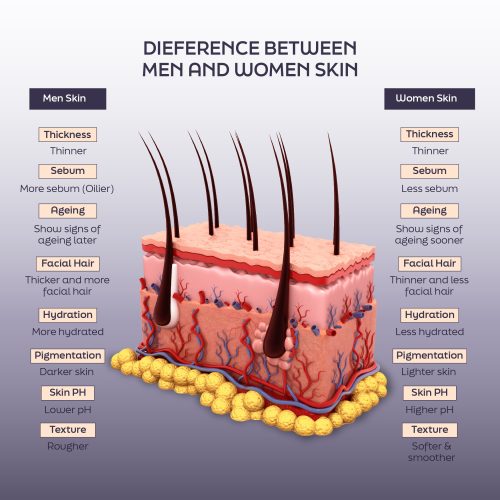HOW MALE AND FEMALE SKIN DIFFER?
Just like women, men face a variety of skin concerns such as sensitivity, irritation, acne, and the signs of aging. However, it is important to recognize that male and female skin possess distinct characteristics that necessitate different approaches to skincare. Men typically have thicker skin with more collagen and active sebaceous glands, leading to differences in skin texture, oil production, and aging patterns compared to women. Women, on the other hand, often experience more hormonal fluctuations that can affect their skin condition. Understanding these distinctions is crucial for developing an effective skincare routine that addresses the unique needs of each gender. This tailored approach ensures that the specific challenges faced by both men and women are met, promoting healthier and more radiant skin for everyone.

What Sets Male and Female Skin Apart?
1. Thickness
Men’s skin is about 20% thicker than women’s, making it less prone to fine lines but more susceptible to deep wrinkles. Collagen in male skin decreases steadily over time, while female skin is particularly affected after menopause.
2. Sebum Production (Oiliness)
Men have larger and more noticeable pores due to active sebaceous glands, leading to approximately twice as much sebum production compared to women. This excess oiliness gives male skin a shinier appearance.
3. Aging
Signs of aging tend to appear later in male skin, but once they do, changes occur more rapidly. Sagging skin, puffy eyes, and dark circles are common concerns for men, along with wrinkles that tend to be more pronounced.
4. Facial Hair
Facial hair is a prominent feature of male skin, influenced by testosterone. Shaving, a common practice for men, can both benefit and irritate the skin, leading to potential inflammation.
5. Hydration
Higher levels of lactic acid in men’s sweat act as natural moisturizers, keeping the skin hydrated. Despite sweating twice as much as women, male skin appears more moisturized due to this higher lactic acid content.
6. Pigmentation
Research suggests that adult females generally have lighter skin pigmentation than males in the same population, possibly due to the increased need for calcium during pregnancy and nursing.
7. Skin pH
Men’s skin tends to have a lower and more acidic pH compared to women’s. However, some studies suggest that gender may not significantly influence skin pH levels.
8. Skin Texture
Male skin is typically rougher and drier compared to the softer and smoother texture of female skin. Testosterone contributes to the thicker and tougher n
In conclusion, understanding the differences between male and female skin is essential for developing effective skincare routines tailored to each gender’s unique needs.

1 thought on “HOW MALE AND FEMALE SKIN DIFFER?”
I used Fratello face wash recently. Great cleansing and moisturization. I did not have any dryness after wash. Definitely recommended